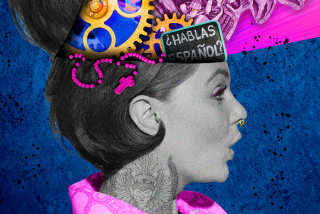‘Mañana Means Heaven’ revisits ‘On the Road’ tryst
Jack Kerouac’s encounter with a “Mexican girl” he calls Teresa, or Terry, takes up about 20 pages of his classic 1957 novel “On the Road.” He’s at a bus station in Bakersfield when he first catches a glimpse of Terry, “the cutest little Mexican girl in slacks,” with hair that was “long and lustrous black” and eyes that were “great big blue things with timidities inside.”
Kerouac ends up spending two weeks with her. The point of the young writer’s life is to keep moving, and when Kerouac takes one last look at Terry as he leaves California on his way back to New York, he knows he’ll never see her again.
“Well, lackadaddy, I was on the road again,” he writes.
With that, “Terry” disappeared from American literature.
Like most of the characters in “On the Road,” “Terry” was based on a real person. Bea Franco was her name, and she was the daughter of farm-working Mexican immigrants. In his poignant new novel “Mañana Means Heaven,” the San Joaquin Valley-raised poet Tim Z. Hernandez reconstructs Franco’s life and her passionate, life-changing encounter with the famous writer in autumn 1947.
In “Mañana Means Heaven,” as in “On the Road,” Franco and Kerouac end up sitting next to each other on the bus, sharing intimacies. When they get to L.A., Franco decides to throw her plans out the window — she’s on her way to see her sister in Boyle Heights — and become Kerouac’s lover and companion.
“A decision, she assured herself, that any warm-blooded woman with a sincere man-soul like Jack nipping at her heels — a college boy with looks that would make Cary Grant throw his hands up — would have made ten times over,” Hernandez writes.
Hernandez combines his skills as a poet and some dogged research to imagine and re-create the couple’s brief relationship with intimate and engrossing detail. The book begins and ends with a description of Hernandez’s real-life interview with Franco, and it’s clear the novel has benefited from Franco’s own account of her life as a farmworker and young mother. When she met Kerouac, she was married to an abusive and womanizing man who was the father of her two children.
More than anything, “Mañana Means Heaven” succeeds as a portrait of midcentury, Mexican American California and the cultural divide that defined the state then but that was only hinted at in its literature. Latinos were often part of the supporting cast mid-20th century fiction of the West: from the unforgettable Camilla in John Fante’s “Ask the Dust,” to the nearly invisible Mexican farmworkers in “The Grapes of Wrath.”
In “Mañana Means Heaven,” Franco’s family is on the farm-to-city-to-farm circuit common for Latino families, splitting time between Boyle Heights and the vineyards of Selma. Memories of life-threatening poverty in Mexico and immigration raids in California shapes the family’s sense of identity. Hernandez captures that reality without being maudlin or angry.
Franco is U.S.-born, but she has memories of being sent to Mexico as a child with her family, in the mass deportations, via railroad, of the 1930s. “Bea wondered why all the mahogany faces had the same wary and complacent look, like they were all going home after a long and disappointing vacation.”
Kerouac’s portrait of Terry in “On the Road” is compelling — and also playful and lyrical. An excerpt from Kerouac’s then still-unpublished novel based on his romance with Franco was published in the Paris Review in 1955 and helped Kerouac get a contract for the entire book. And the passages in which Kerouac describes his wanderings in Los Angeles with Terry are some of the most evocative descriptions the city ever committed to the printed page.
But reading Hernandez feels like being transported into a time machine and being shown other textures in the California landscape that Kerouac, an outsider, could not possibly have seen.
In “On the Road,” Terry is called a “whore” by her father for hanging out with Sal, Kerouac’s fictional alter ego. But in “Mañana Means Heaven” Franco dishes out to her father as much as she takes and often finds a way to fight back against the closed-minded men in her life. Later, in the field, she teaches Kerouac how to pick grapes.
“You’re going to have to squat low, like this,” she tells Kerouac. “But you gotta do it quick.” There are “pacers” working in the fields, Franco explains, and the future novelist is surprised to learn “a guy can’t go at his own speed.”
There are a handful of unfortunate anachronisms and errors in “Mañana Means Heaven.” For instance, no one would have called the highway over the Tejon Pass “Interstate 5” in 1947, since the Interstate Highway System wasn’t created until a decade later. But those are the smallest of hiccups in what is otherwise a meticulously researched and skillfully crafted novel that convincingly places us inside the California that was — and that makes us feel like voyeurs allowed a glimpse inside the inner workings of another novel that remains an American classic.
What’s more, “Mañana Means Heaven” gives a beautifully realized portrait of Bea Franco. It ends in 2010 with Franco in her 90s. She died last month at age 92; according to Hernandez, she received a finished copy of his novel the week before she died.
A surprising twist is revealed in the novel’s final sentence, with Franco speaking a few words that reveal, indirectly, exactly how she felt about the lover who later became a famous novelist.
Mañana Means Heaven
Tim Z. Hernandez
University of Arizona Press: 230 pp., $24.95
More to Read
Sign up for our Book Club newsletter
Get the latest news, events and more from the Los Angeles Times Book Club, and help us get L.A. reading and talking.
You may occasionally receive promotional content from the Los Angeles Times.







